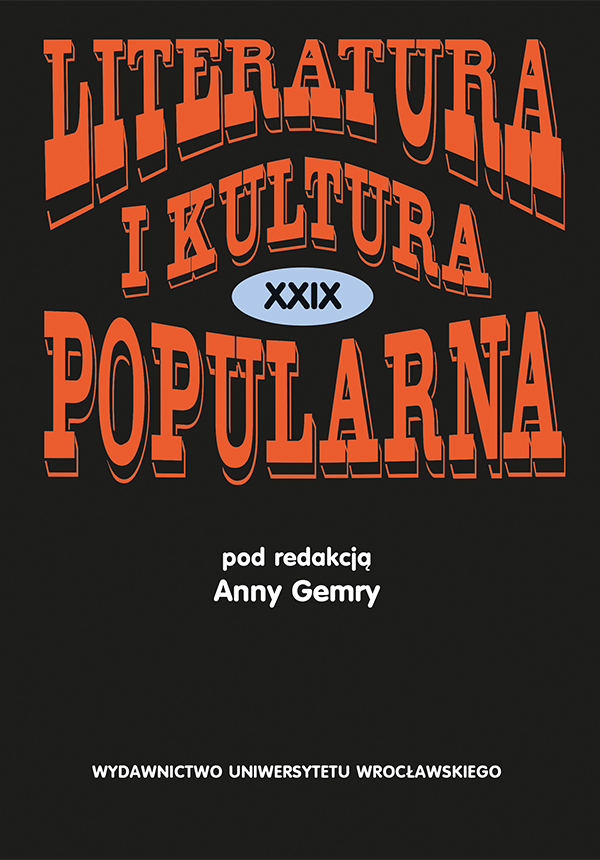

Articles

The concept of hauntology, created by Jacques Derrida, reveals new meanings of those literary works whose essence are liminal places, that are binding the past and the present and former and present tenants with the yoke of crime. Such places include both the crypt from The Fall of the House of Usher (1839) by Edgar Allan Poe and the basement from the novel Domofon [The Intercom] (2005) by Zygmunt Miłoszewski. These become places where spectres live. Both works are connected by the aesthetics of Gothicism, a gloomy houses visited by a stranger, the frail mental and physical condition of the inhabitants, the motifs of painting, the gradually discovered history of the locations, hiding some dark tragedy and, above all, the underground part of the building, inhabited by spectral female figures demanding justice for the wrongs suffered. The ghostly perspective allows us to distinguish in the construction of the presented world the traumatic moment when the ghost has been born (the story of the haunted palace, Marianna’s tragedy), the place haunted by it (the catacombs of the estate, the basement of the block of flats) and the type of manifestation of the ghostly figure (vampiric Lady Usher, beautiful Marianna) along with the way it affects the characters (apparent madness, apathy, the motif of surviving the night). The endings of both works are parallel, when the buildings tremble in their foundations, and also by symbolical union of the Usher twins, that in Miłoszewski’s text.
Derrida J., Widma Marksa, przeł. T. Załuski, Wydawnictwo Naukowe PWN, Warszawa 2016.
Miłoszewski Z., Domofon, Wydawnictwo W.A.B., Warszawa 2005.
Poe E.A., Zagłada domu Usherów, [w:] E.A. Poe, Opowieści niesamowite, przeł. B. Leśmian, S. Wyrzykowski, Muza, Warszawa 2002, s. 244–268.
Szekspir W., Hamlet, przeł. J. Paszkowski, Państwowy Instytut Wydawniczy, Warszawa 1976.
Butler D.W., Usher’s Hypochondriasis: Mental Alienation and Romantic Idealism in Poe’s Gothic Tales, „American Literature” 1976, nr 1, s. 1–12.
Fiddler M., Ghosts of Other Stories: A Synthesis of Hauntology, Crime and Space, „Crime, Media, Culture” 15, 2019, nr 3, s. 463–477.
Hall C.S., Lindzey G., Teorie osobowości, przeł. J. Kowalczewska, J. Radzicki, Wydawnictwo Naukowe PWN, Warszawa 2002.
Heller M., Ewolucja kosmosu i kosmologii, „Urania” 1978, nr 2, s. 34–44.
Hoffman D., Poe Poe Poe Poe Poe Poe Poe, Louisiana State University Press, Baton Rouge 1972.
Izdebska A., Gotyckie labirynty, [w:] Wokół gotycyzmów: wyobraźnia, groza, okrucieństwo, red. G. Gazda, A. Izdebska, J. Płuciennik, Wydawnictwo Uniwersytetu Łódzkiego, Łódź 2003, s. 33–41.
Jameson F., Marx’s Purloined Letter, [w:] J. Derrida, Ghostly Demarcations: A Symposium on Jacques Derrida’s “Specters of Marx”, red. M. Sprinker, Verso, London 2008, s. 26–67.
Kasperski E., Edgar Allan Poe. Tożsamość i konteksty. Wprowadzenie do lektury, „Tekstualia” 2009, nr 1, s. 15–34.
Kidwai A.R., Newey V., The Burning Heart in Poe’s “Al Aaraaf”: Another Possible Source, „Notes and Queries” 1997, nr 3, s. 365–366.
Kozak Ł., Upiór. Historia naturalna, Fundacja Evviva L’arte, Warszawa 2021.
Lyra F., Edgar Allan Poe, Wiedza Powszechna, Warszawa 1973.
Marzec A., Widmontologia, Fundacja Nowej Kultury Bęc Zmiana, Warszawa 2015.
Olkusz K., Konglomerat niesamowitości: Domofon Zygmunta Miłoszewskiego jako gra z klasycznym modelem literatury weird fiction, „Literatura i Kultura Popularna” 15, 2009, s. 105–130.
Pisula E., Autyzm. Od badań mózgu do praktyki psychologicznej, Gdańskie Wydawnictwo Psychologiczne, Sopot 2012.
Różkiewicz T., Tytułowa posiadłość w Zagładzie domu Usherów jako fizyczna reprezentacja zmie- niającej się psychiki bohaterów, [w:] Poe-Land: studia i szkice, red. K. Maciąg, O. Weretiuk, E. Rokosz-Piejko, G. Jagiełło, Wydawnictwo Uniwersytetu Rzeszowskiego, Rzeszów 2017, s. 134–142.
Rybicka E., Od poetyki przestrzeni do polityki miejsca. Zwrot topograficzny w badaniach literackich, „Teksty Drugie” 2008, nr 4, s. 21–23.
Sinko Z., Wstęp, [w:] M.G. Lewis, Mnich, przeł. Z. Sinko, Zakład Narodowy im Ossolińskich — Wydawnictwo, Wrocław 1964, s. III–LXXIX.
Studniarz S., Tragiczna wizja. Rzecz o nowelistyce Poego, Wydawnictwo Adam Marszałek, Toruń 2008.
Wydmuch M., Gra ze strachem. Fantastyka grozy, Czytelnik, Warszawa 1975.
Zwolińska B., Wampiryzm w literaturze romantycznej i postromantycznej: na przykładzie Opowieści niesamowitych Edgara Allana Poego, Poganki Narcyzy Żmichowskiej oraz opowiadań Stefana Grabińskiego, Wydawnictwo Uniwersytetu Gdańskiego, Gdańsk 2002.
Miejsce, Słownik Języka Polskiego PWN, https://sjp.pwn.pl/sjp/;2482896.
Porfirogeneta, Słownik Języka Polskiego PWN, https://sjp.pwn.pl/slowniki/porfirogeneta.html.
Strzelecki D., Józefowicz O., Indukowane zaburzenia urojeniowe, oprac. M. Stelmach, Psychiatria po Dyplomie, 2015, https://podyplomie.pl/psychiatria/19066,indukowane-zaburzenia-urojeniowe.
Do piwnicy (Do pivnice), reż. J. Švankmajer, Czechosłowacja 1983.